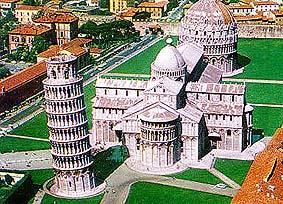


All the structures

Pisa, rising 4 m. above sea level on the banks of the Arno river, on a fertile alluvial plain, is approximately 10 km. from the Tyrrhenian Sea.
A centre of ancient origin, Pisa was already an important port in Roman times, definitively asserting itself as a seagoing power in the 12th century when it became a Republic after participating in the First Crusade. It extended its influence over the whole Tuscan coast and Sardinia, succeeding in defeating its rival Amalfi and the Saracens. This period was the start of the town's phase of greatest economic prosperity and artistic splendour.
In the 13th century, the antagonism of Genoa, Lucca and Florence soon had a negative effect on the power of Pisa, which to after defeat by the Genoese at Meloria, was radically reduced.
After a period of domination by the Signorie, the town's decline culminated with its defeat by Florence in 1406.
Monuments: First and foremost is, without doubt, the Campo dei Miracoli (Piazza Duomo), one of the most famous sights in Italy and the world. Here lies the Duomo (11th-12th century), one of the major examples of Romanesque-Pisan art, with five aisles and housing important works of art such as the pulpit by G. Pisano (early 14th century) and the tomb of Arrigo VII (14th century); close by stands the world-famous Leaning Tower (bell tower, started in 1173), an elegant round construction; the Romanesque Baptistry, to a circular plan and the Camposanto (13th century), unfortunately damaged during the last war, housing extremely fine frescoes (14th and 15th century).
An active centre of culture favoured also by excellent road and rail links, Pisa has an active industrial sector: engineering, textiles, pharmaceuticals, glassandpottery, foodstuffs and building. There is also lively cultural activity linked to the University and Scuola Normale. At all times, Pisa is thronged with tourists.
Famous People: Galileo Galilei (scientist, 1564-1642), Antonio Pacinotti (physicist, 1841-1912), Ippolito Rosellini (Egyptologist, 1800-1843), Giovanni Pisano (sculptor, 1250-1314), Antonio Pisanello (artist, 1395-1455).
Cultural Institutions: S. Matteo National Museum (Tuscan sculptures and paintings of 12th to 15th centuries), Mineralogical Museum, Paleontological Museum, Museo delle Sinopie, Zoological Museum, Domus Mazziniana, Domus Galilaeana, University, Scuola Normale Superiore. In the Province: S. Miniato (environmental interest), Cascina (industry), Pontedera (engineering), Volterra (city of art, Palazzo dei Priori, Etruscan Museum, Accademia dei Sepolti).